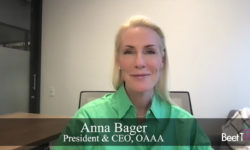Consumers have more ways than ever before to get news, information and entertainment, challenging marketers to stand out with their latest advertising campaigns. The pandemic added to this transformation of the media marketplace as millions of people spent more time at home, connecting with the outside world through television, computer and mobile screens.
Media consumption behaviors changed in unexpected ways that underscored the need for a transformation in brand advertising, said Melissa Grady, chief marketing officer of Cadillac, and Michael Law, chief executive of Carat US. They discussed the forces that are shaping marketing strategies in this Beet.TV video hosted by Jon Watts, executive director of The Project X Institute.
“Going into the pandemic, I thought linear TV was going to see a bit of a renaissance, and that is not what happened,” Grady said. “We have an audience-first approach. When we look at linear TV, it’s part of a wider video portfolio. As we’re seeing streaming rise and seeing TV fall, those other elements in the portfolio are becoming more and more important.”
More households connected their TVs to the internet, opening up pathways to a wider selection of on-demand and linear content – and to exposure to advertising that’s more targeted and even personalized.
“One of the other trends will be: how can brands integrate themselves into that content to create a better user and commercial experience and how do brands become content themselves?” Law said. “We can’t just put an ad on a TV show at eight o’clock and 40 million people show up. It’s become a much more personalized user experience.”
He said television advertising is powerful with its ability to provide multisensory content and have an emotional effect on viewers. Newer platforms like TikTok and Snapchat offer their users ways to engage with what they see, though major brands also want to achieve broader reach with their campaigns.
“That sight sound and motion still rule, but every time you can create a really cool experience that gets customers’ attention and engagement, that’s going to get them more embedded with the brand and feeling the brand a little bit more,” Law said.
Specialized Television
The growth in streaming has pushed marketers to develop strategies to reach viewers who watch less linear television. Programming has become specialized as more scripted shows appear on streaming platforms, while live linear television features content with a short shelf-life, such as news and sports.
“For us, the role of TV has been changing over the past couple of years,” Cadillac’s Grady said. “The role of linear for us has been moving more to a tentpole-type moment.”
She cited the Super Bowl as one example of an event that generates large-scale viewership, appearing on linear television and streaming. She also said marketers are re-thinking the way they tell a brand story that isn’t limited to the 30-second spot that has been a television mainstay for decades. Cadillac recently created 60-second documentaries that appear on Twitch, the livestreaming platform owned by Amazon.
“People think they hate advertising, but they don’t when, if you ask anyone why they’re watching the Super Bowl, it’s to see the great ads,” Grady said. “It’s our job to be telling these stories in the right way that people want to hear them.”
You are watching “Advertising Transformation: What’s Next for Converged TV and Video,” a Beet.TV Virtual Leadership Summit presented by Mediaocean. For more videos, please visit this page.














































